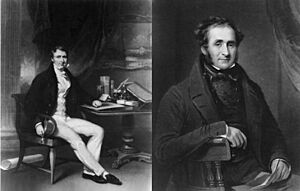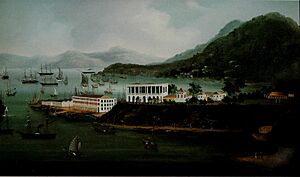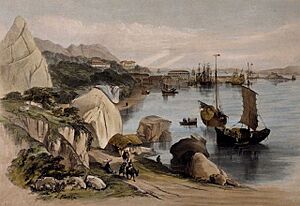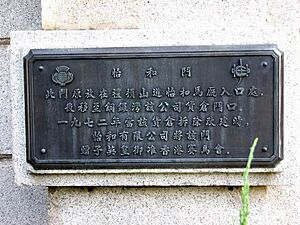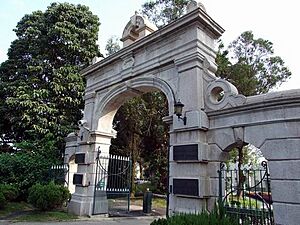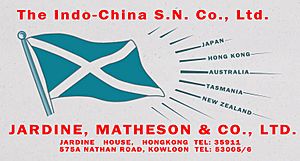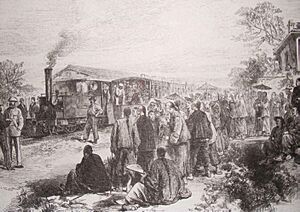- This page was last modified on 17 October 2025, at 10:18. Suggest an edit.
History of Jardine Matheson & Co. facts for kids
Jardine, Matheson & Co. was a big trading company started in 1832 by two Scotsmen, William Jardine and James Matheson. They traded things like cotton, tea, and silk. The company began in Canton (now Guangzhou, China). In 1844, they moved their main office to the new British colony of Hong Kong. From there, they grew their business all along the coast of China.
By the end of the 1800s, Jardine, Matheson & Co. was the largest foreign trading company in Asia. They expanded into many areas, including shipping, cotton factories, and building railways. In the early 1900s, they grew even more, adding cold storage, packing, and brewing businesses. They also became the biggest cotton producer in Shanghai.
After China became the People's Republic of China in 1949, it became very hard for foreign companies to do business there. Jardines left mainland China in 1954 and focused on their business in Hong Kong. They did not return to mainland China until 1979, when China started to open up its economy.
Contents
How Trade Began in China
For a long time, British and other countries traded with China. Chinese silk and tea became very popular in Britain. However, China did not need many goods from Britain. The Chinese emperors worried about foreigners coming into their country. So, they made many rules to limit trade with outsiders. This was called the Canton System.
From the mid-1700s, foreign merchants could only trade in a small area of Canton. They traded with a group of Chinese merchants called the Cohong. These merchants worked from special buildings called the Thirteen Factories along the Pearl River.
The Company's Early Days
William Jardine was born in Scotland in 1784. He studied medicine at Edinburgh University. At 19, he became a surgeon on ships of the British East India Company. These ships sailed between London, China, and India. He did this for 14 years. As a senior officer, Jardine had space on the ship to do his own trading. He soon found that trading made more money than being a doctor.
During these early years, Jardine met a Parsee Indian named Jamsetjee Jeejebhoy. They formed a trading partnership that lasted many years. In Canton, Jardine also met Charles Magniac. Jardine learned ways to trade even with the East India Company's rules. In 1819, Jardine left his job and started his own trading firm. In 1822, he became a free merchant in Canton. Later, in 1828, he joined Magniac & Co., which was the company before Jardine Matheson & Co.
James Matheson was born in Scotland in 1796. He also went to Edinburgh University. In 1815, he started working as a merchant in Calcutta. He traded goods and services for his uncle's company. After some time, Matheson went to Canton. There, he became an independent merchant. He worked as an agent for companies trading with India. He then joined a partnership called Yrissari & Co. This company quickly became one of the top five trading houses in China. After Mr. Yrissari died, Matheson closed the company. He inherited all of Yrissari's shares. This gave Matheson a great chance to join Jardine.
Matheson was a perfect partner for Jardine. James Matheson and his nephew, Alexander Matheson, joined Magniac and Co. in 1827. William Jardine was known as the planner and a tough negotiator. James Matheson was known for handling the company's letters and legal matters. He also came up with many new ideas for the company. Jardine was tall and serious, while Matheson was shorter, cheerful, and loved the arts. Both men were very hardworking and focused on building wealth.
Jardine, Matheson & Co. Becomes a Private Company
For a long time, the East India Company was not popular in Britain. This was because they had a monopoly, meaning they were the only ones allowed to trade with Asia. After America became independent in 1776, American merchants started a successful tea trade with China. This made many people question why the East India Company still had its monopoly.
To start a business in China, a British person could become a consul for another country. This meant they would be protected by that country's laws. Jardine used this method. He became the Danish Consul. This way, Jardine and his partners did not have to worry about the East India Company. In fact, Jardine even helped the East India Company when their ships were held up by Chinese officials. This earned him their thanks.
Jardine, Matheson & Co. played a big part in ending the East India Company's monopoly in China in 1834. After the East India Company left, Jardine, Matheson & Co. quickly filled the gap. That year, they sent the first private shipments of "Jardines' Pickwick tea mixture" from China to Britain. Jardine Matheson then became the largest British trading company in Asia. William Jardine was called "Tai-pan" by other traders, which means 'Great Manager' in Chinese.
Jardine's company used fast, elegant tea clippers (ships) that could out-sail most rivals. This helped them be the first to get tea to customers. For example, their ship Sylph set a speed record, sailing from Calcutta to Macao in just over 17 days. Jardines was also the first company to hire a special 'tea taster' in China. This helped them understand different teas and get the best prices.
Growing the Business
In 1832, the company was officially named Jardine Matheson and Company. William Jardine, James Matheson, and other partners were part of it. The company later took the Chinese name "Ewo" (怡和洋行), which means "Happy Harmony." This name came from a respected Chinese trading house. By 1830, Jardine Matheson controlled about half of China's foreign trade.
In the mid-1830s, trading with China became harder. The Chinese government tried to stop silver from leaving the country. Tea trade was very popular in Britain, but it was not simple. The British government charged a high tax on tea. This led to a lot of smuggling to avoid paying the tax. To make money in the China trade, companies had to be faster than everyone else. Fast ships raced home with new tea to get the best prices.
William Jardine wanted to expand trade in China. In 1834, he tried to talk with Chinese officials in Canton, but it did not work. The Chinese Viceroy ordered the area where Lord Napier (a British trade official) was staying to be blocked. Lord Napier was held hostage and later died.
After this, William Jardine saw a chance to convince the British government to use force to open up trade. In 1835, he sent James Matheson to Britain to push for strong action. Matheson met with government officials and gathered support for a war with China. His efforts helped lead to the First Opium War.
Jardine left China in 1839 to continue Matheson's work in Britain. He met with Lord Palmerston, the British Foreign Secretary. Jardine convinced Palmerston to go to war with China. He even gave him a detailed plan with maps and strategies.
War followed, and in 1842, the Treaty of Nanking was signed. This treaty opened five major Chinese ports for trade. It also officially gave the island of Hong Kong to Britain. Hong Kong had already been used as a trading and military base since 1841. Trade with China grew, and Jardine, Matheson and Co. became known as the "Princely Hong" because it was the biggest British trading company in East Asia.
By 1841, Jardines had 19 large ships and hundreds of smaller boats. They traded sugar and spices from the Philippines. They exported Chinese tea and silk to England. They also worked as cargo agents, insurance agents, and rented out dock space.
Hong Kong is an island near the Pearl River. In 1840, it seemed like a place with no future. It was hot, humid, and unhealthy. Only about 5,000 fishermen and quarry workers lived there. Pirates were also thought to use the island as a hiding place. The only good thing about it was its natural deep-water harbor. The name "Hong Kong" comes from the Cantonese words meaning "fragrant harbor."
James Matheson strongly believed in Hong Kong's future. He thought that if China made trade harder in Canton, it would push more trade to the new English settlement. He also knew Hong Kong had one of the best harbors in the world. Many other merchants did not share his excitement. Early builders faced many problems, including typhoons, fires, and a serious malaria sickness. Even Queen Victoria was not impressed with the island at first.
Despite these problems, the company's founders did not give up. Hong Kong offered a great chance for Jardine's to grow. In 1841, Jardines bought three large plots of land at East Point for £565. This is where they set up one of the first offices in the new colony. Today, the Excelsior hotel, once owned by Jardine, is on the site of Lot No. 1. Jardines was the first to build a brick and stone house at East Point. They still own most of that original property.
Jardines built warehouses, docks, offices, and houses on the island. They also created facilities to maintain their ships. The company helped develop Hong Kong's infrastructure. They provided business leadership, credit, and services to the growing community. In the early years, they built Hong Kong's first ice-making factory. They also started the first spinning and weaving factory and helped create the Hong Kong Tramways.
The Hong Kong General Chamber of Commerce was founded in 1861. Jardine's 7th Tai-pan, Alexander Perceval, was its first chairman. In 1878, the company started sugar refining in Hong Kong.
Many landmarks in Hong Kong show Jardine's history. The company built homes on The Peak because it was cooler and healthier there. "Jardine's Lookout" is a famous hilltop. From here, people would watch for Jardine's ships coming from India and London. As soon as a ship was seen, a fast boat would collect the mail. This helped the directors get market information quickly. Jardine's Bazaar is one of Hong Kong's oldest shopping streets, dating back to 1845. The Noonday Gun, near the Excelsior Hotel, dates to the 1860s. It was fired daily at noon as a penalty after Jardine's private guards fired a salute that upset the British Navy.
In Shanghai, Jardine, Matheson & Co. was the first to build on the Bund in 1843. Their first building was finished in 1851. By 1900, the land they bought for £500 was worth £1,000,000. A new five-story building was completed in 1922. It had a special silk room for inspectors. Today, this building is home to the Shanghai Foreign Trade Bureau.
In 1862, William Keswick helped save the Shanghai Race Club from financial trouble. The company also opened new offices in other trading centers like Fuzhou and Tianjin. In the late 1800s, Jardines changed from just being an agent to a more varied business. They traded many different goods, promoted railways, and started banks and insurance companies as China modernized.
Growing and Expanding Businesses
Jardines made huge profits in its early years. The company was so powerful that people joked about who had the most power in Hong Kong: the Royal Hong Kong Jockey Club, Jardine, Matheson & Co., the Hong Kong & Shanghai Banking Corporation, and then the Governor.
Shipping Goods
Shipping was very important for the company's growth. In 1835, Jardines ordered the first merchant steamship in China, called the Jardine. It was meant to carry mail and passengers. However, Chinese officials did not like the "fire-ship" on the Canton River. They fired on it, and the ship had to turn back. The Jardine was sent to Singapore for repairs.
Jardines started a cargo shipping line from Calcutta in 1855. They also began operating on the Yangtze River. The Indo-China Steam Navigation Company Ltd. was formed in 1881. This company managed a network of ocean, coastal, and river shipping services for Jardines until 1939.
Building Railways
Jardines tried for many years to get China to build a railway system, but it was difficult. In 1876, Jardines tried on its own. They formed the Woosung Road Company to buy a 10-mile road between Shanghai and Wusong. They wanted to turn it into a railway, which would be the first in China. The railway opened on July 3, 1876. However, Chinese officials ordered the train service to stop. The Chinese government bought the line and dismantled it. The rails were shipped to Taiwan and left to rust. The line was not rebuilt until 1898.
Jardines later helped build other railways in China. They worked with the Chinese Engineering and Mining Company to build a tramway. This tramway eventually grew into the China Railway Company. In 1898, Jardines and the Hongkong and Shanghai Banking Company (HSBC) created the British and Chinese Corporation (BCC). This company was responsible for building much of China's railway system. For example, the Shanghai to Nanjing line was built by Jardines between 1904 and 1908. They also built the Kowloon–Canton Railway.
Docks and Buildings
Jardines and Sir Paul Chater helped form The Hongkong and Kowloon Wharf and Godown Company Limited in 1886. Three years later, they also created The Hongkong Land Investment and Agency Company Limited (later Hong Kong Land). This new company's first project was to reclaim land for building along a new waterfront road, which became Chater Road. Jardine, Matheson & Co. also managed many wharves and warehouses in Shanghai.
Star Ferry
The Star Ferry Company, which runs ferries between Hong Kong island and the Kowloon peninsula, was bought by the Jardine/Chater controlled Hongkong and Kowloon Wharf and Godown Company Limited in 1898.
Hong Kong Tramways Ltd.
Jardines also helped start Hong Kong's tram system. It began as an electric tram in 1904.
Other Businesses
Insurance
Jardines started its insurance business in 1836 to support its shipping. It offered insurance services in many places where the company had offices. By 1860, it was still the only insurance company in China. The Canton Insurance office later became the Lombard Insurance Co.
Jardine Engineering Corporation
What became Jardine Engineering Corporation (JEC) in 1923 grew from Jardine's Engineering Department. This department imported machinery, tools, and industrial equipment to help China develop. JEC brought new technologies to Hong Kong, like ammonia-type air conditioners and fluorescent lighting. In 1935, they provided the vault doors for the new headquarters of The Hongkong and Shanghai Banking Corporation.
International Business
Jardines was the first foreign trading company to set up in Japan in 1859. They opened offices in Yokohama, Kobe, and Nagasaki. They did a lot of business there, including imports, exports, shipping, and insurance. Jardines also operated in Nairobi, Kenya, and had a stake in a South African company.
Jardine, Matheson and Co. became a limited company in 1906. It was often called the "Firm" or the "Muckle House" (meaning "great house" in Scottish).
The EWO Companies
From the late 1800s, Jardines created new companies using their Chinese name "EWO." The first was the EWO Cotton Spinning and Weaving Co., founded in Shanghai in 1895. It was the first foreign-owned cotton factory in China. By 1921, three cotton mills were combined as Ewo Cotton Mills, Ltd. Before World War II, these mills had many cotton spindles and looms. The company also made other cotton products.
The Ewo Yuen Press Packing Company was started in Shanghai in 1907. It packed raw cotton, silk, wool, and other goods for shipping.
In 1920, Jardines started the Ewo Cold Storage Company in Shanghai. This company made and exported powdered eggs, mainly to the United Kingdom. This egg trade became very important for China's economy in the 1920s and 1930s.
In 1935, the company built the EWO Brewery Ltd. in Shanghai. It started making beer in 1936. EWO Breweries became a public company under Jardines' management in 1940. The brewery made Pilsner and Munich beers. The business was sold in 1954.
Imports and Exports
Before the Japanese invasion of China in 1937, Jardines was a major importer and exporter of many goods. Tea and silk were very important exports. Jardines had been exporting teas since 1801. After the East India Company's monopoly ended in 1834, Jardines quickly grew its tea business. By the 1890s, they exported large amounts of different Chinese teas. Ships full of these teas sailed from China to Europe, Africa, and America.
Silk was also a big part of Jardine's business for its first 100 years. Before the war, they shipped silk from Japan to America, France, Switzerland, and England. For many years, the company even had its own silk factory. Jardines also owned large warehouses in many Chinese cities. These warehouses stored products from different parts of China, like wool, furs, beans, oils, and bristles. Hong Kong and Shanghai were the main centers for imports and exports. Branch offices also traded in goods from timber to food, textiles to medicines, and wines to cosmetics.
Partner Companies
From early on, Jardines worked with "correspondents" in other countries. These companies acted as agents for Jardines. In London, Matheson & Co., Ltd., founded in 1848, acted as Jardine's correspondent. It was controlled by Jardines and the Keswick family. In New York, Balfour, Guthrie & Co., Ltd. handled Jardine's business in the United States. Jardine also had partner companies in Africa, Asia, and Australia.
Jardine Aircraft Maintenance Company (JAMCo)
In the 1940s, Jardines started an Airways Department. It provided services like general agents and booking agents for airlines. British Overseas Airways Corporation (BOAC) appointed Jardines as their main agent for Hong Kong and China.
In Hong Kong, Jardines created JAMCo to provide technical and maintenance services for airlines. JAMCo later merged with Cathay Pacific's maintenance business to form HAECO in 1950.
War and Leaving Mainland China
The 1930s and 1940s were very difficult for foreign companies like Jardines in China. There was unrest, the Second World War, and the Communist revolution in 1949. During 1935–1941, Jardines had two leaders, Sir William Johnstone "Tony" Keswick in Shanghai and his younger brother Sir John "The Younger" Keswick in Hong Kong.
In 1941, Tony Keswick was shot in the arm by a Japanese official. He then traveled in an armored car that used to belong to Al Capone. The same year, John Keswick had to escape Hong Kong when the Japanese took over on Christmas Day 1941. He went to Ceylon (Sri Lanka). Both brothers secretly worked for British Intelligence during the war.
Many of Jardines' staff were held in camps. Others had to leave for Macau or other places. Chinese staff risked their lives to help their imprisoned colleagues.
When the war ended in 1945, the British took control of Hong Kong again. John Keswick returned to rebuild the company's damaged facilities. In Shanghai, he tried to work with the Communists, who had invited capitalists to help rebuild the economy. He thought they would be better than the Nationalists.
By 1949, it became very hard to do business in the new People's Republic of China. By the end of 1954, Jardines had sold, moved, or closed all its businesses in mainland China. They lost millions of dollars in the process.
After the War: New Directions
After the war, Jardine's Hong Kong business faced a challenge from the British trade embargo against China during the Korean War (1950–1953). However, between 1950 and 1980, the company changed a lot. Jardines looked for new markets to replace the ones they lost in China.
When the Korean War ended in 1953, Jardines continued to trade with China through the annual Canton Fair. In 1954, Jardines expanded into Southeast Asia by investing in Henry Waugh and Co., which had businesses in Malaya, Singapore, Thailand, and Borneo.
In the late 1950s, John and Tony Keswick bought the last shares of the Jardine family in the company. In 1961, the company's shares were offered to the public on the Hong Kong Stock Exchange. The Keswick family kept about 10% of the company.
1960s: New Ventures
The Mandarin Oriental Hotel opened in 1963. It was the first five-star hotel in Hong Kong's financial district. A year later, Jardine's company Dairy Farm bought the Wellcome supermarket chain. Wellcome has since become one of Asia's largest retail businesses.
Even though trade with mainland China almost stopped during the Cultural Revolution in 1966, Jardines still managed to sell six passenger airplanes to the Chinese Government. The company also opened offices in Australia in 1963 and in Jakarta in 1967.
1970s: More Growth
In 1970, Asia's first merchant bank, Jardine Fleming, opened. This showed that Asia's financial markets were growing. In 1972, Jardines opened the Excelsior hotel in Hong Kong. It was built on the same spot where James Matheson bought the first land for the company over 120 years before.
Henry Keswick, a leader of Jardines, arranged to buy Reunion Properties, a large real estate company in London, in 1973. This deal almost doubled Jardine's assets. In the same year, Jardines also bought Theo H. Davies & Company, a trading company in the Philippines and Hawaii that owned sugar plantations. When world sugar prices rose sharply, Jardines made a lot of money.
Jardines also took advantage of Hong Kong's building boom. In 1975, they bought Gammon Construction, a leading construction company. That same year, they entered the luxury car market by buying Zung Fu Motors, which sold Mercedes-Benz cars in Hong Kong.
By 1979, the company had 50,000 employees around the world.
In 1979, Jardines returned to mainland China after more than 25 years. They opened one of the first foreign offices in Beijing. A year later, Maxim's Catering, partly owned by Dairy Farm, started the Beijing Air Catering Company Ltd. This was the first foreign joint venture in mainland China after the "open door" policy began. Jardine Schindler followed as the first industrial joint venture.
Jardines also expanded its insurance businesses during this decade. This led to the creation of Jardine Insurance Brokers.
1980s: Changes and Challenges
By 1980, Jardines had businesses in many countries and employed 37,000 people. They continued to grow their businesses. They expanded their car interests to the United Kingdom. They opened Hong Kong's first 7-Eleven convenience store. They also got the Pizza Hut and IKEA franchises in Hong Kong and Taiwan. Jardine Pacific was created to bring together the Group's trading and services in the region.
In 1980, some people tried to buy a large share of Jardines. To stop this, the company's leader, David Newbigging, restructured Jardine Matheson and Hongkong Land. This made it impossible for anyone to take control of either company. However, this also put both companies in debt.
In 1982, Jardines celebrated its 150th anniversary. They set up the Jardine Foundation, which offers Jardine Scholarships to students from Southeast Asia to study at Oxford and Cambridge universities.
Simon Keswick became the leader in 1983. He quickly worked to reduce the company's debt. He also created a new management system with separate divisions for Hong Kong, International, and China.
In 1984, Jardine Matheson Holdings Limited ('JMH') was formed in Bermuda. This was done to make sure the company would be under British law. Two years later, Dairy Farm and Mandarin Oriental were listed on the Hong Kong stock exchange.
In 1988, Brian M. Powers became the first non-British leader of Jardines. He successfully defended the company against takeover attempts by other powerful businessmen. He did this by splitting the group into two linked parts, Jardine Matheson and Jardine Strategic. This made them very hard to take over.
1990s: Moving Listings and New Partnerships
In the early 1990s, Jardine Matheson Holdings and other group companies listed their shares on the London Stock Exchange, in addition to Hong Kong.
In 1994, Jardine Matheson delisted from the Hong Kong Stock Exchange (Hang Seng Index). They moved their main listing to London. This was done to give the company more security before Hong Kong's handover from British to Chinese rule in 1997. Chinese officials saw this as a negative sign for Hong Kong's future. However, the company's business continued to be managed from Hong Kong, and its focus remained on East Asia.
In 1999, Jardine Fleming, a joint venture, was restructured. Jardine Matheson gained a stake in Robert Flemings Holdings, which was later sold to Chase Manhattan Bank.
Other important events in this decade included the merging of Jardine Insurance Brokers to form Jardine Lloyd Thompson. Dairy Farm also bought a big stake in Indonesia's leading supermarket group Hero. Mandarin Oriental also started to expand its hotels.
2000s: New Investments and Charity
In the 2000s, Jardine Cycle & Carriage acquired a large stake in Astra International. Hongkong Land also became a full subsidiary of the Group.
In 2002, the Group started MINDSET, a charity focused on mental health. In 2010, they opened MINDSET Place, a home for people recovering from mental illness.

